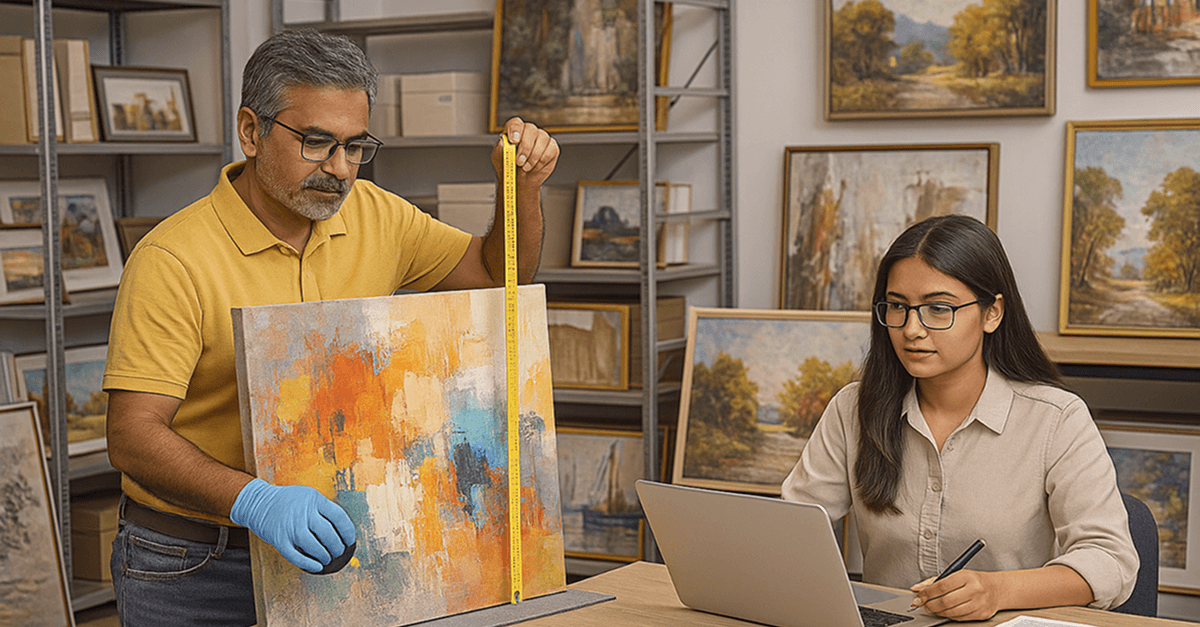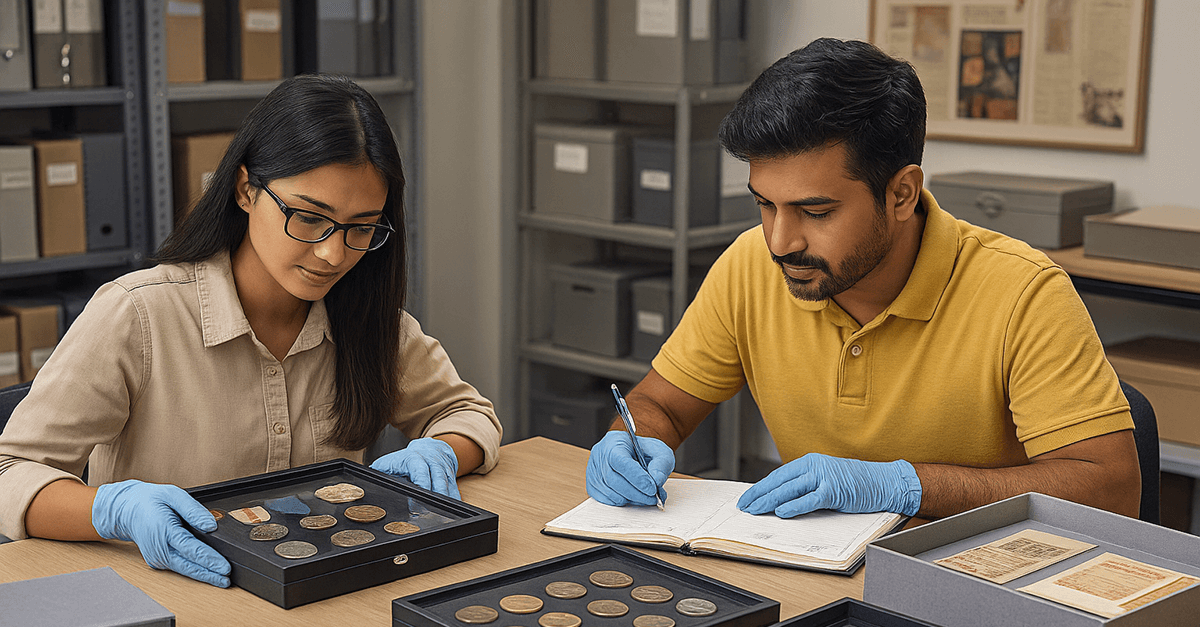Introduction: The Balancing Act Between Archiving and Display
Collectors acquire art not only for investment but also for enjoyment. Paintings brighten homes, sculptures enliven office spaces, and textiles or photographs bring culture into everyday life. But here’s the dilemma: the more art is displayed, the higher the risk of damage.
On the other hand, artworks stored in secure archival systems may remain safe, but they are hidden from daily appreciation. This creates a fundamental tension: archiving vs display.
In India, where climatic conditions (humidity, dust, and pollution) already stress artworks, the balance becomes even more delicate. How can collectors enjoy their art while also preserving it for the long term? This blog explores that balance, highlighting the risks of display, the importance of safe storage, and strategies for achieving both.
What is Archiving in the Context of Art?
Archiving refers to systematic preservation and documentation of artworks, ensuring they remain safe, accessible, and well-documented for the future.
Key elements of archiving include:
- Cataloging: Documenting metadata, provenance, and condition.
- Safe storage: Using climate-controlled facilities, archival-quality materials.
- Digitisation: Creating high-resolution digital records.
- Monitoring: Regular inspections for early signs of damage.
Archiving focuses on longevity and minimises exposure to risk.
What is Display in the Context of Art?
Display refers to showcasing artworks for enjoyment or public engagement — whether in homes, offices, museums, or galleries.
Benefits of display:
- Aesthetic pleasure for owners and viewers.
- Cultural enrichment in workplaces and public spaces.
- Increased recognition and prestige for collectors or institutions.
However, display carries inherent risks that archiving seeks to minimise.
Risks of Permanent Display
1. Light Damage
- UV rays from sunlight or harsh artificial lights fade pigments and degrade textiles.
- Works on paper and textiles are especially vulnerable.
2. Environmental Stress
- Fluctuations in humidity and temperature cause cracking, warping, or mold growth.
- Air conditioning without humidity control accelerates problems.
3. Dust and Pollution
In Indian metros, dust and soot deposits are unavoidable. Over time, these settle into paint layers.
4. Handling Damage
Frequent moving, cleaning, or re-hanging increases risk of accidental scratches, tears, or falls.
5. Pests
Textiles, wooden frames, and paper attract termites, silverfish, and moths.
Display ensures visibility but often shortens the lifespan of artworks if not balanced with proper precautions.
Safe Storage Practices: The Backbone of Preservation
1. Climate Control
- Maintain 18–22°C temperature and 50–55% relative humidity.
- Use dehumidifiers during monsoon and humidifiers in dry seasons.
- Avoid storing art near kitchens, bathrooms, or exterior walls prone to dampness.
2. Lighting Controls
- Store artworks in darkened spaces when not on display.
- Use UV-protective covers for framed works.
3. Archival Materials
- Acid-free folders, pH-neutral boards, archival boxes.
- Cotton gloves for handling to prevent oil transfer.
- Padded supports for sculptures.
4. Pest Management
- Inspect storage spaces regularly.
- Use non-toxic, conservation-approved pest deterrents.
5. Digital Archiving
Photograph and digitise works for reference and sharing without exposing originals.
Safe storage doesn’t mean hiding art away forever. It means having a structured system where works are stored most of the time and displayed selectively.
Balancing Archiving and Display
The goal is not to choose between archiving and display but to integrate both.
1. Rotational Display
- Display selected artworks for a period, then return them to storage to “rest.”
- Rotate displays seasonally to reduce cumulative exposure.
2. Controlled Environments
- Invest in UV-filtered glass and climate-controlled display areas.
- Museums in India often use double glazing to reduce both heat and UV exposure.
3. Use of Digital Reproductions
- For corporate lobbies or high-exposure areas, use high-quality digital reproductions.
- Originals can be displayed selectively during events.
4. Hybrid Archiving-Display Systems
- Create digital archives for research, insurance, and sharing.
- Physically display only a fraction of the collection at a time.
This way, collectors can enjoy art without compromising preservation.
The Indian Context: Why Storage is Often Neglected
Many collectors in India face practical challenges:
- Space constraints: Homes and offices may lack storage rooms.
- Awareness gaps: Collectors may not realise the risks of constant display.
- Climate: High humidity and pollution accelerate damage.
- Legacy collections: Families inherit art but lack structured archiving systems.
Professional archiving services bridge this gap, offering customised solutions for Indian conditions.
Step-by-Step Guide to Safe Art Storage
- Inventory & Cataloging
- Start with a complete catalog of all works.
- Record provenance, condition, and valuations.
- Start with a complete catalog of all works.
- Segmentation of Collection
- Identify works for regular display vs those requiring permanent storage.
- Identify works for regular display vs those requiring permanent storage.
- Archival Packaging
- Wrap works in acid-free tissue, use pH-neutral mounts.
- Sculptures stored with padded supports.
- Wrap works in acid-free tissue, use pH-neutral mounts.
- Storage Environment Setup
- Dedicated room with climate control.
- HEPA filters to reduce dust.
- Dedicated room with climate control.
- Monitoring & Maintenance
- Condition reports updated annually.
- Inspections for pests, dampness, and pollution.
- Condition reports updated annually.
- Digitisation
- Create digital surrogates to reduce handling of originals.
- Create digital surrogates to reduce handling of originals.
Case Examples
Case 1: Corporate Collection in Mumbai
A large corporate house with 300+ artworks adopted rotational display. Artworks are displayed for three months, then returned to climate-controlled storage. Employee engagement remains high, while condition risks are minimised.
Case 2: Private Collector in Hyderabad
Inherited miniatures and textiles were digitised, cataloged, and stored in archival boxes. Reproductions were displayed in the home, with originals kept in safe storage.
Case 3: Museum in Delhi
Exhibition loans required detailed archiving before and after display. The museum adopted hybrid systems, balancing visibility with long-term preservation.
Best Practices for Collectors
- Invest in archival storage even for small collections.
- Document everything — catalog entries, condition reports, photos.
- Use digital archives to reduce need for physical handling.
- Plan display schedules rather than leaving works exposed indefinitely.
- Engage professionals for setup and maintenance of storage environments.
Benefits of Balancing Archiving and Display
- Preservation of Value: Protects both aesthetic and financial worth.
- Cultural Enjoyment: Allows art to be appreciated without constant exposure.
- Insurance Confidence: Well-archived collections are easier to insure.
- Legacy Protection: Ensures heirs inherit structured, well-preserved collections.
Conclusion: Enjoy Art Today, Preserve It for Tomorrow
Art brings joy when displayed, but it gains endurance when archived. The key for collectors is not to choose one over the other but to integrate both smartly.
By adopting safe storage practices, rotational display, and digital archives, collectors in India can protect their artworks while still enjoying their cultural and aesthetic presence.Explore how our Art Archiving Services at TurmericEarth can help you strike this balance. From archival packaging to climate-controlled storage strategies, we ensure your collection is both enjoyed in the present and preserved for the future.








